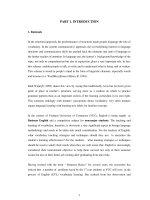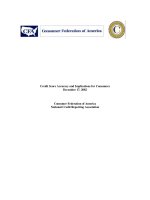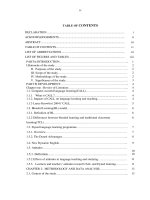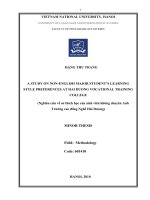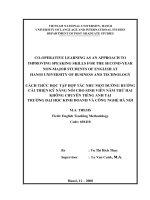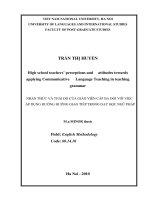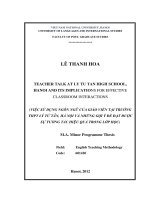Students’ pragmatic awareness and implications for English classroom teaching at Vietnam University of Commerce = Nhận thức ngữ dụng học của sinh viên và các gợ
Bạn đang xem bản rút gọn của tài liệu. Xem và tải ngay bản đầy đủ của tài liệu tại đây (1.02 MB, 75 trang )
VIETNAM NATIONAL UNIVERSITY, HANOI
UNIVERSITY OF LANGUAGES AND INTERNATIONAL STUDIES
FACULTY OF POST-GRADUATE STUDIES
o0o
PHẠM THÙY GIANG
STUDENTS’ PRAGMATIC AWARENESS AND IMPLICATIONS
FOR ENGLISH CLASSROOM TEACHING
AT VIETNAM UNIVERSITY OF COMMERCE
(Nhận thức ngữ dụng học của sinh viên và các gợi ý cho việc giảng dạy
Tiếng Anh tại Trường Đại học Thương mại)
Summary of M.A Minor Thesis
Field: English Language Teaching Methodology
Code: 60.14.10
HANOI – 2012
1
VIETNAM NATIONAL UNIVERSITY, HANOI
UNIVERSITY OF LANGUAGES AND INTERNATIONAL STUDIES
FACULTY OF POST-GRADUATE STUDIES
o0o
PHẠM THÙY GIANG
STUDENTS’ PRAGMATIC AWARENESS AND IMPLICATIONS
FOR ENGLISH CLASSROOM TEACHING
AT VIETNAM UNIVERSITY OF COMMERCE
(Nhận thức ngữ dụng học của sinh viên và các gợi ý cho việc giảng dạy
Tiếng Anh tại Trường Đại học Thương mại)
Summary of M.A Minor Thesis
Field: English Language Teaching Methodology
Code: 60.14.10
Supervisor: Nguyen Bach Thao, M.A
HANOI – 2012
iv
TABLE OF CONTENTS
Declaration of originality i
Acknowledgements ii
Abstract iii
Table of contents iv
Lists of abbreviations vii
List of tables viii
PART I: INTRODUCTION
1
1. Rationale
1
2. Aims of the study
2
3. Research questions
2
4. Scope of the study
2
5. Significance of the study
2
6. Design of the study
3
PART B: DEVELOPMENT
4
CHAPTER 1: LITERATURE REVIEW
4
1.1. Pragmatics
4
1.1.1. Definitions 4
1.1.2. Aspects of Pragmatics 4
1.1.2.1. Speech acts 5
1.1.2.1.1. Definitions 5
1.1.2.1.2. Categories of speech acts 5
1.1.2.2. Pragmalinguistics 6
1.1.2.2.1. Definitions and aspects of pragmalinguistics 6
1.1.2.2.2. Directness v.s indirectness 7
1.1.2.3. Sociopragmatics 7
1.1.2.3.1. Definitions 7
1.1.2.3.2. Aspects of sociopragmatics 8
1.1.2.3.2.1. Politeness 8
v
1.1.2.3.2.2. Cultural norms 9
1.2. Pragmatic awareness
9
1.2.1. Definitions 9
1.2.2. Difference between awareness of pragmalinguistics and sociopragmatics 10
1.2.3. Previous studies 11
CHAPTER 2: METHODOLOGY
14
2.1. Situation analysis
14
2.2. Methods of the study
14
2.3. Research design
15
2.3.1. Sample and sampling 15
2.3.2. Instruments 15
2.3.3. Data collection 17
2.3.4. Data analysis 17
CHAPTER 3: FINDINGS AND DISCUSSIONS
18
3.1. Awareness of greeting
19
3.2. Awareness of addressing
20
3.3. Awareness of introducing
22
3.4. Awareness of requesting and responding
23
3.5. Awareness of inviting and responding
27
3.6. Awareness of parting
28
3.7. Awareness of thanking and responding
30
3.8. Awareness of conversation topics
32
3.9. Summary of the findings
34
CHAPTER 4: IMPLICATIONS
35
4.1. Raising students’ pragmalinguistic awareness
35
4.2. Raising students’ awareness of politeness
36
4.3. Raising students’ awareness of cultural norms
36
4.3.1. Integrating culture into language teaching 36
4.3.1.1. Enforcing the teaching of British and American cultural background 36
4.3.1.2. Creating culture-rich learning environment 36
4.3.2. Designing a cultural syllabus 37
vi
4.3.3. Providing more authentic teaching materials 38
4.4. Improving the pragmatic teaching in the way of holding tests and exams
. 39
4.5. Developing teachers’ competence
39
PART C: CONCLUSION
41
1. Summary of the study
41
2. Limitations of the study
41
3. Suggestions for further studies
42
REFERENCES
43
APPENDICES
vii
LIST OF ABBREVIATIONS
VUC Vietnam University of Commerce
ESL English as a second language
EFL English as a foreign language
viii
LIST OF TABLES
Table 3.1:
Average percentage of appropriate responses by speech acts
Table 3.2:
Students‘ awareness of greeting
Table 3.3:
Students‘ awareness of addressing
Table 3.4:
Students‘ awareness of introducing
Table 3.5:
Students‘ awareness of requests and responses
Table 3.6:
Students‘ awareness of inviting
Table 3.7:
Students‘ awareness of parting
Table 3.8:
Students‘ awareness of thanks and responses
Table 3.9:
Students‘ awareness of conversation topics
1
PART I: INTRODUCTION
1. Rationale
English, as an international communication tool, is the most widely used all over
the world. As a result, it is absolutely vital for many Vietnamese learners to have a good
command of English so that they can communicate effectively with foreigners. However,
many Vietnamese learners even those who are good at reading and writing with sufficient
knowledge of English grammar and vocabulary still fail in communicating with
foreigners. Although they may have little difficulty in understanding the literal meaning
of the target language in authentic communication situations, they cannot interpret the
utterances correctly, or express themselves appropriately. One of the reasons is that they
lack necessary pragmatic knowledge; that is, they are not aware of the social, cultural, and
discourse conventions that have to be followed in various situations like many other
proficient speakers of English (Bardovi-Harlig, 1999). This is understandable because
according to Bachman (1990), in order to be successful in communication, it is essential
for foreign language learners like Vietnamese students to know not just grammar and text
organization but also pragmatic aspects of the target language. Once they are not aware of
English pragmatic aspects, they may be incapable of using the target language effectively
in intercultural communication. In other words, low pragmatic awareness results in many
communication breakdowns.
As a teacher of English at Vietnam University of Commerce, from her own
observations and experience, the researcher has noticed that VUC students often get
difficulties in communicating in English when involving in different communication
situations in classrooms as well as in real-life encounters. Many of them do not employ
appropriate strategies and do not use relevant linguistic forms to perform a speech act.
They engage in communication activities without paying attention to factors that
influence the communication such as the relationship with the other interlocutor. The
situation is worse when they interact with native speakers. As they are not exposed much
to real-life situations, they often feel stuck. They may not understand what native
speakers mean or are unable to make appropriate utterances in different situations.
Especially, they often violate politeness or cultural norms, thus leading to their difficulty
or even failure in intercultural communication. This maybe due to the fact that they are
not really aware of pragmatic aspects or do not put great emphasis on them.
